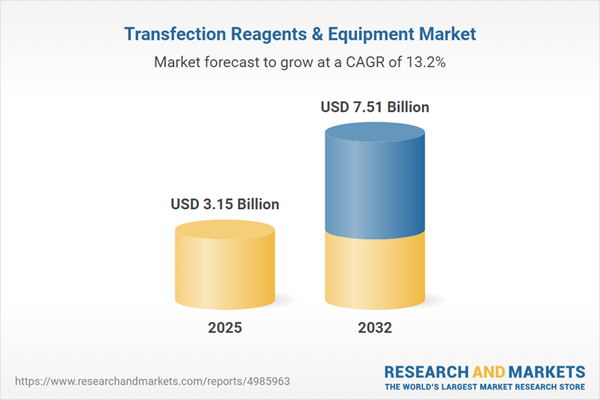Speak directly to the analyst to clarify any post sales queries you may have.
Transfection reagents and equipment stand as critical enablers in modern life sciences, giving research and development leaders the tools to advance gene editing, drug discovery, and synthetic biology. The transfection reagents & equipment market is shaped by continuous innovation and increasing application depth across biotech, pharmaceutical, and academic sectors.
Market Snapshot: Transfection Reagents & Equipment Market Growth Trends
The transfection reagents & equipment market grew from USD 2.79 billion in 2024 to USD 3.15 billion in 2025 and is projected to reach USD 7.51 billion by 2032, reflecting a CAGR of 13.15%. This sustained growth is driven by expanding research activity, accelerated advancements in gene therapy, and the widespread adoption of precision medicine. Mature biotech clusters and new academic initiatives globally are fueling demand for advanced molecular delivery solutions. Organizations in both established and emerging markets are prioritizing platforms that offer operational flexibility and alignment with evolving regulatory standards.
Scope & Segmentation of the Transfection Reagents & Equipment Market
This analysis delivers an in-depth exploration of the transfection landscape, assessing market dynamics, leading players, and changing innovation needs. Segmentation addresses technologies, cell models, applications, and regional context to provide actionable clarity for decision-making.
- Product Types: Transfection equipment and reagents.
- Cell Types: Bacterial, insect, mammalian, and plant cells.
- Applications: Cell line development, drug discovery, gene therapy research.
- End User Categories: Academic and research institutes, biopharmaceutical companies, contract research organizations.
- Regions Covered: Americas (including North and Latin America), Europe, Middle East & Africa, and Asia-Pacific territories.
- Key Technology Focus: Chemical reagent innovation, electroporation advancement, automation in microfluidics, viral vector engineering, nanoparticle-mediated delivery.
- Leading Companies Analyzed: Agilent Technologies, Altogen Biosystems, Applied Biological Materials, Bex Co., BioVision, Bio-Rad Laboratories, Cytiva, GeneCopoeia, Qiagen, Thermo Fisher Scientific.
Key Takeaways for Senior Decision-Makers
- Rising complexity in gene editing, drug screening, and molecular diagnostics is catalyzing demand for both chemical and hardware-driven transfection platforms.
- Reagent and equipment providers are focused on developing adaptable, high-throughput, and automated systems suitable for diverse research needs and regulatory requirements.
- Regional variance in funding, regulatory stringency, and sourcing dynamics is shifting distribution strategies and emphasizing local partnerships and production.
- Strategic collaborations, mergers, and alliances between instrument manufacturers and reagent developers are accelerating the introduction of integrated solutions.
- Growth in clinical research, particularly cell and gene therapies, is expanding the addressable market and prompting investment in next-generation transfection modalities.
- Stakeholder value hinges on the ability to balance innovation in delivery technologies with cost-effective scale-up, supply chain resilience, and compliance.
Tariff Impact on the Transfection Market
The 2025 imposition of new tariffs in the United States is prompting a reassessment of global supply chains for transfection reagents and equipment. Procurement teams are exploring alternative sources and negotiating long-term agreements to guard against cost instability. Some manufacturers are localizing production or forming regional partnerships to decrease reliance on international logistics and buffer against price volatility. Distributors are optimizing inventory control by balancing buffer stocks with the perishability risks of critical reagents. Regulatory processes have adapted to support uninterrupted flows of biotechnology materials essential for ongoing research and public health initiatives, emphasizing the need for agile supply and procurement strategies.
Research Methodology & Data Sources
The report leverages a dual-method approach, combining primary interviews with equipment engineers, scientists, and procurement leaders, and a thorough review of peer-reviewed studies, patents, and industry white papers. Segmentation analysis and expert validation cycles ensure robust, relevant, and reliable insights into both current dynamics and future trends.
Why This Report Matters
- Navigate complex regulatory and supply chain environments with informed strategies tailored for transfection reagent and equipment markets.
- Benchmark against leading industry players and emerging technologies to guide R&D investments and operational planning.
- Align product development and market entry with nuanced segmentation and evolving regional demand across global life science hubs.
Conclusion
Leaders who act on these insights will position their organizations to capture new opportunities and maintain research continuity despite market disruptions. The transfection reagents & equipment segment remains central to innovation, enabling future progress across biotechnology and therapeutic development.
Additional Product Information:
- Purchase of this report includes 1 year online access with quarterly updates.
- This report can be updated on request. Please contact our Customer Experience team using the Ask a Question widget on our website.
Table of Contents
3. Executive Summary
4. Market Overview
7. Cumulative Impact of Artificial Intelligence 2025
Companies Mentioned
The companies profiled in this Transfection Reagents & Equipment market report include:- Agilent Technologies, Inc.
- Altogen Biosystems
- Applied Biological Materials, Inc.
- Bex Co.,ltd.
- BioVision Inc.
- Bio–Rad Laboratories, Inc.
- Cytiva
- GeneCopoeia, Inc.
- Qiagen N.V.
- Thermo Fisher Scientific Inc.
Table Information
| Report Attribute | Details |
|---|---|
| No. of Pages | 191 |
| Published | November 2025 |
| Forecast Period | 2025 - 2032 |
| Estimated Market Value ( USD | $ 3.15 Billion |
| Forecasted Market Value ( USD | $ 7.51 Billion |
| Compound Annual Growth Rate | 13.1% |
| Regions Covered | Global |
| No. of Companies Mentioned | 11 |









